Swordtail fish are popular freshwater aquarium fish known for their unique tail fin shape and vibrant colors. They thrive in well-maintained aquariums with a temperature range of 65-82°F (18-28°C) and a pH between 7.0 and 8.3. These social fish prefer a planted tank with plenty of swimming space. A balanced diet of flake food, live, and frozen foods is recommended for optimal health. It’s important to note that swordtails are livebearers, meaning they give birth to live young rather than laying eggs.
Table of Contents
Swordtail Fish Care
Swordtail fish are very adaptable and can flourish in a multitude of environments. These fish are excellent choices for beginners. Since they are so active, they significantly benefit from having ample room to swim around. The smallest aquarium size for a swordtail to survive is roughly around 20 gallons.
Swordtail Fish Overview
Swordtail fish, known for their distinct, elongated tail fins, are popular in home aquariums. Swordtails are sociable and best kept in groups, showing a wide range of colors and patterns. They require a balanced diet and a well-maintained tank with ample space for swimming. Regular water changes and monitoring for common fish diseases are essential for their well-being. Compatibility with other fish species should be considered when introducing swordtails to a community tank.
It is not often that you come across a livebearer freshwater fish that meets the demands of living in captivity and having a comfortable and fulfilling life. Well, the swordtail fish is one of the few variants that you can consider adding to your home aquarium.
Swordtail fish (Xiphophorous hellerii) is a trendy community aquarium fish. Their popularity stems from their ease of care and peaceful nature. They have unique fins with a great variety of colors, commonly referred to as Red or Green swordtails. Today, they are bred to achieve various colors and, as a result, great deals of different types exist.
They live in groups but are not schooling fish. One thing that makes them so popular is their hardiness, as they can survive in very diverse environments.
Whether you plan to keep them as a single aquarium species or in a community aquarium, you should know their general needs. And, this article is going to be a detailed guide about everything you possibly need to know about freshwater swordfish and how to take care of them in captivity.
| Information Chart | Swordtail Fish |
| Scientific Name | Xiphophorous hellerii |
| Family | Poeciliidae |
| Care level | Easy |
| Temperament | Peaceful |
| Color | Olive green |
| Lifespan | 3-5 years |
| Size | Up to 6.5 inches |
| Diet | Omnivore |
| Minimum tank size | 10-20 gallons |
| Temperature | 70-82°F |
| Water conditions | Freshwater with low stream |
| Tank mate compatibility | Peaceful temperament and sociable |
Swordtail Fish Appearance
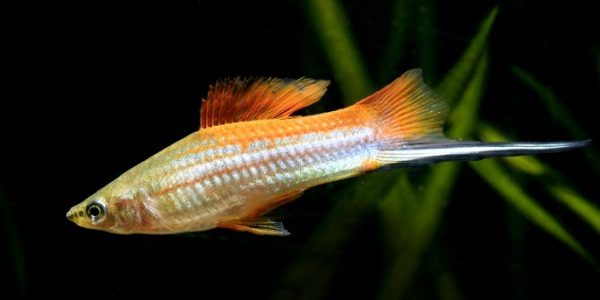
When you first look at a swordtail fish, the first striking feature is the caudal fin. The elongated lower lobe design around their tail mimics the appearance of a sword and hence the name. However, this typical sword-like structure is only visible in males, making the sexual dimorphism a lot easier to understand.
As for the color variants, most of these small freshwater fishes feature a typical olive green color on the body with reddish-brown stripes all over. The “sword” portion around the tails in males is composed of yellow color with black edges around.
However, the diverse breeding culture in pet aquariums across the world has diversified their color variants. So, olive green, but you can also find red, orange, and even black variants. Also, one of the key markers that they are under stress is when their color intensifies drastically.
Lifespan of Swordtail Fish
The typical swordtail fish lifespan is between three to five years, typical for livebearer freshwater fishes. Their lifespan does depend on the kind of living conditions they are in and the diet they are being given.
The level of care has a significant impact on their health and overall well-being. However, conditions like genetic predisposition and diseases can cut short their lifespan drastically.
Swordtail Fish Size
The typical swordtail fish size is up to 6.5 inches. The female ones are larger and can reach up to 6.5 inches, while the male ones grow up to 5 to 5.5 inches in size. This is despite the males having an elongated tail.
Natural Habitat and Origin
The swordtail fish, otherwise scientifically known as Xiphophorus helleri are freshwater fishes from North and Central America. They are from the Poeciliidae family, the same as platies and guppy. Although they are medium-sized fishes, they are a common addition to community tanks because of their stunning appearance and sociable nature.
They are prolific livebearers, which means that they can comfortably spawn in captivity. This is ideally helpful for commercial aquarists. Not only are they abundantly found in pet stores, but they are also sold by home aquarists who are expert breeders.
As for their natural habitat, these freshwater fishes tend to be found around the province of Mexico and Honduras in the rivers and streams. They are ideally suited to brackish water bodies that have low levels of salinity.
Besides, swordtail fish is also often crossbred with the Southern Platy because of their similarities in appearance and origin.
Swordtail Fish Care and Tank Setup
Swordtails thrive in well-maintained aquariums with temperatures between 65-82°F and pH levels of 7.0-8.3. These social fish prefer a planted environment with ample swimming space. A varied diet of flake, live, and frozen foods is recommended for their health. Notably, Swordtails are livebearers, giving birth to live young instead of laying eggs.
Swordtail Fish Tank Size and Specifications
Swordtail fish are average-size fish; they don’t need very much space due to their size, but given they are very active, they greatly benefit from having enough space to swim around. The reason why these fishes are highly ideal for beginners is because they are adaptable to changes.
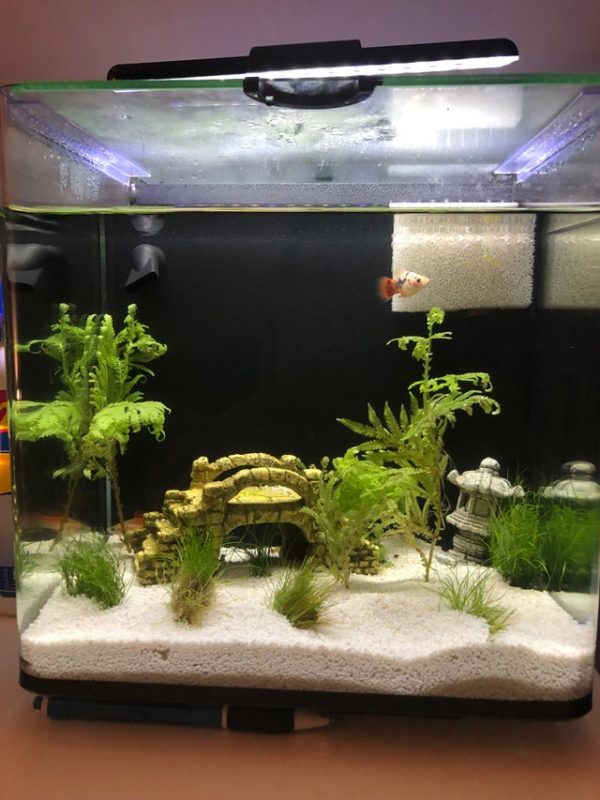
So, even if you fail to maintain the optimal water parameters and tank setup, the swordtail fish will acclimatize itself to the new environment to live a comfortable life in the tank. However, since you are their caregiver, knowing about the basic tank setup necessities is always advisable. Here’s what you should know.
Optimum Tank Size for Swordtail Fish
The recommended swordtail tank size for a swordtail fish is 15-20 gallons. Although they are not schooling fishes, they still move around in groups for comfort and confidence, especially in the community tanks.
Besides the fact that swordtails need to be in groups, these individual fishes are very active too. So, putting them in a small tank will restrict free movement and put them under stress.
If you are keeping a larger group of swordtail fish, we’d recommend starting with a 30-gallon tank to provide each of them with ample space to swim around with maximum comfort.
Filter Type
Since the swordtail fish is naturally found in brackish water with a low water current and streamflow, they don’t require a high-power filter in the tank. You can rely on a low-speed pump with a filter outlet to mimic the slow streaming current in the water for a comfortable movement in the home aquarium.
Substrate
Swordtail fishes tend to navigate towards the middle and the top layer of the home aquarium, so you wouldn’t have to pay any close attention to the substrate. However, if you want to mimic their natural habitat, dark-colored sand in the bottom of the tank does the job just fine.
Besides the sand, you can add bigger chunks of rocks and bogwood to replicate their wildlife further. These also help them in hiding when they need some time to relax instead of being surrounded by their group.
How many Swordtail Fish in a 20-gallon tank?
When you are just starting with housing swordtail fishes in your tank, make sure to start with 5-6 in a 20-gallon tank and then increase the number as you get a larger tank.
Water Parameters for Swordtail Fish
Although it is true that swordtail fish isn’t very particular about the tank setup, you need to be extra mindful about the water parameters. Swordtail fish are sturdy tropical fish that can tolerate a wide range of water temperatures.
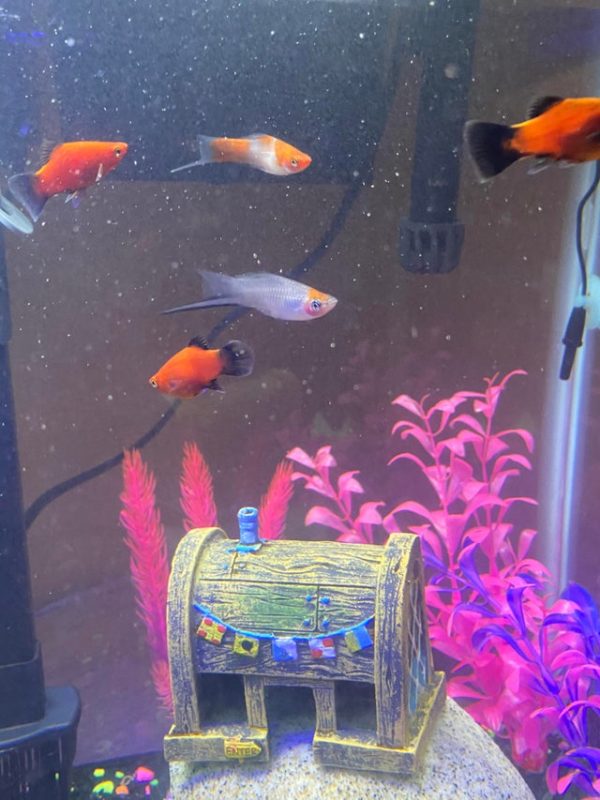
Since they come from Belize, Guatemala, and Mexico, where the water is filled with vegetation and low salinities, you also need to mimic the same environment in the home tank. The best part about housing a swordtail fish is their compatibility. You can more or less pair them with any kind of other freshwater fish, and they will adapt to the changing water parameters to optimize their health and well-being.
Their adaptive nature is what makes them a public favorite among the different aquarists, especially the beginners. If you are looking for particular directions about the water parameters for a swordtail fish, here’s what you need to know:
Water Temperature
The ideal water temperature for swordtail fish is 65°F to 82°F. However, try to maintain the temperature between 72-79 degrees Fahrenheit because it provides optimum comfort.
pH level
The perfect water pH level for swordtail fish is 7.0 to 8.4, which means they thrive in neutral to alkaline water conditions. So, ensure that you check the water pH every few days with a pH paper to prevent the water from getting too acidic or too alkaline.
Water hardness
The swordtail fishes require very hard water conditions between 12-35 dGH. Your pet market expert will give you tips about maintaining the water hardness when you buy the fish from them.
Besides all that, always take care that your water is adequately filtrated. If you set your filtration system right, the water parameters will stay strong. Always keep track of water parameters so you can react and prevent possible complications. Your fish will then happily thrive and live to full potential.
Swordtail Fish Tank Landscape
Now that we have discussed the tank setup and the water parameters, we move on to the tank landscape. As mentioned, swordtail fish thrive in heavy vegetation since they originally grew up in the wild.
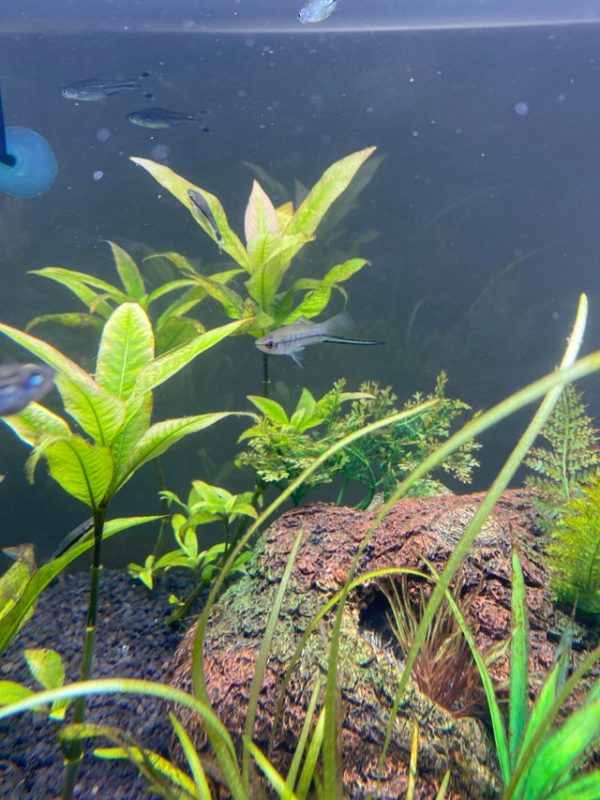
So, while you want to replicate those living conditions in the home aquarium, you don’t necessarily want to go overboard with the same. Your primary focus should be on the natural biotope setup before anything else.
Plants for Swordtail Fishtank
When decorating the tank for a swordfish, you want to be extra careful with the type of plants and their placement. Always include plants that naturally vibe well with and the ones that will enable them to hide when they need to. You don’t need to focus on the substrate much since they aren’t bottom feeders.
However, you need to be mindful of the plants you want. Stick to living plants instead of the artificial plastic ones. Some of the best types of plants for these tanks include:
They provide them with the space to hide when they need to and leave behind enough areas in the tank where the fishes can comfortably swim around without any discomfort.
Also, when adding plants, make sure that you get a covered tank lid because swordtail fishes are jumpers and will come to the surface and try to take a leap of faith out of the tank.
Feeding Swordtail Fish
Swordtail fish will accept a wide variety of foods. You can give them quality flake food or live foods like bloodworms, daphnia, brine shrimp, mosquito larvae, or fruit flies, as they will eat virtually anything.
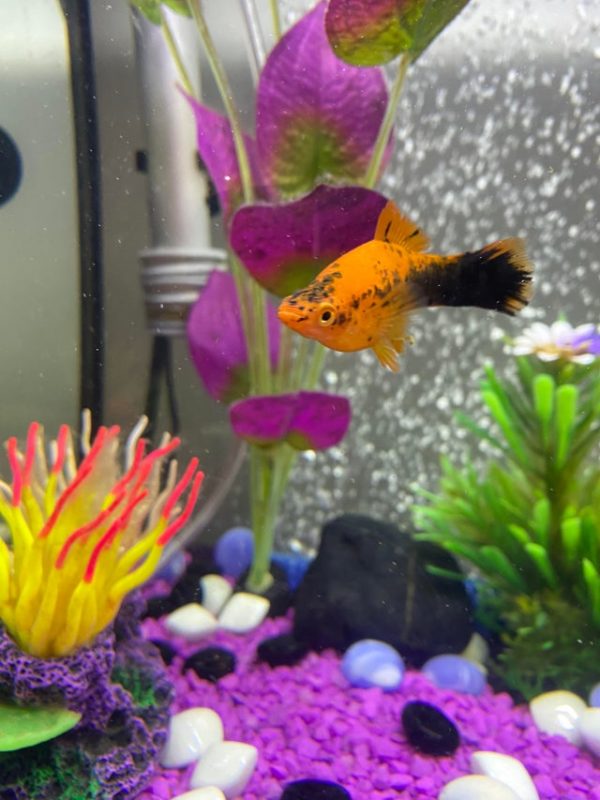
Swordtail fish eat a lot of algae and other vegetation in their natural habitat. Don’t neglect their need for proper herbivorous food. Make sure to give them an ideal mix of protein and vegetation to perfectly satisfy their exact diet needs.
When juveniles, they depend on protein-rich foods to build up their strength to move around the tank comfortably.
As for their feeding frequency, you need to be extra careful because they will gobble down everything you give them. However, overfeeding can lead to severe complications to their health and their lifestyle.
Stick to feeding them 2-3 times daily because they don’t need a lot of food. Feed them what they can finish in 1-2 minutes, which should be more than enough to suffice them throughout the day. Also, since they aren’t bottom feeders, you want to clear out the excess food they don’t eat to prevent unnecessarily dirtying the tank.
Swordtail Fish Behavior and Temperament
The swordtail fish care is one of the easiest because they get along well with other tankmates. They are perfect for larger community tanks, provided that you take care of their water parameters and feeding habits.
The swordfish is pretty peaceful and friendly and will gel well with other tank mates. They aren’t necessarily shoaling species, but they should be kept in a group of 5-6 to help them feel comfortable in the tank. Also, keep the ratio of females more in comparison to male ones.
The male swordtail fish can get territorial, which means that you don’t want to keep many male ones in the same tank. Try to limit the number of males to 2-3 and double that up with female ones so they can live in harmony.
Swordtail Fish Tank Mates
Swordtail fish are a peaceful and active species. They are very social and enjoy good company, mainly when housed with other swordtails or similar passive species. The swordtail fish can make a great companion in similar cousins, such as platies, mollies, or angelfish. Peaceful types of corydoras are also great as their companions. Some larger types of tetras can be great, too, but keep them in schools of five or more to prevent possible harassment.
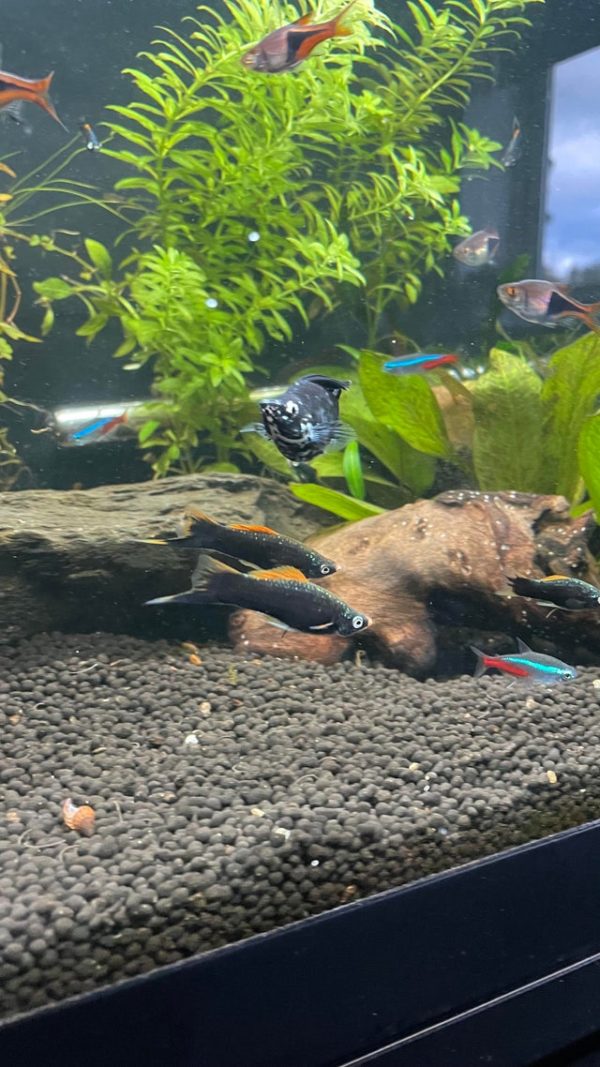
Male swordtail fish are almost always aggressive towards other males of the same species. If your tank isn’t huge, you should opt to keep only one male along with two or three females in one tank.
So, when you are sitting there wondering about swordtail fish tank mates, try to pair them with ones that are either of similar size or similar temperament, so you don’t have to worry about signs of aggression, fin nipping, and other associated disasters.
The one downside to keeping swordfish is that they aren’t natural defenders. So, if you keep them with boisterous fishes, they will try to hide away under the plants and be under consistent stress, something you don’t want.
Some of the best tank mates for the swordtail fish include:
Breeding Swordtail Fish
As livebearers, the swordtail fish are great at breeding efficiently and very quickly, without any intervention from the aquarist. Once a swordtail female has been impregnated, you should see a huge belly with a dark gravid spot near the anal fin.
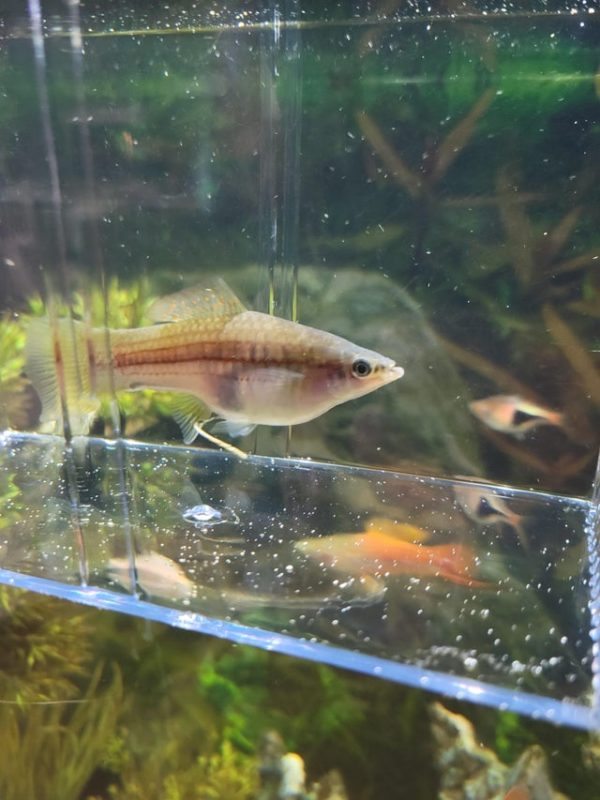
Once the fry is born, you should take some protective measures to keep them alive; otherwise, they will be consumed by their parents or other tank mates. You can do this either by adding more plants that will serve as hiding spots for young fry or by physically removing adults (or fry, for that matter) from the tank.
The latter is much more efficient, as only some of the young will survive if they are not separated from the adults. When the fry becomes large enough not to be viewed as food by adults, gently introduce them to your tank.
If kept in the right living conditions, the female swordfish can spawn and give birth every 28 days. Also, when you are considering breeding them, try to shift the adult fishes to a different breeding tank to regulate the ideal temperature and water conditions for successful breeding.
Also, in the breeding tank, try to maintain an optimal temperature of 80-degrees Fahrenheit. Since both the male and female fishes don’t have parental instinct after birth, you need to ensure that you remove the adults after spawning or provide the tank with enough small plants to hide the young ones from the adult fishes.
For the diet of the fry, you need to depend on small flakes and pellets in the beginning and then switch to adult foods like infusoria and brine shrimp. The young ones need to be fed by the aquarists till they are big enough to float and swim around the tank.
Swordtail Fish Diseases and their Treatment
Although swordtail fishes are hardy fishes, they aren’t immune to the common diseases that most freshwater species suffer from. If you notice any signs of unnecessary aggression or consistent lethargy in the fish, it is a sign of illness. Sometimes, swollen belly is also a common sign of an infection.
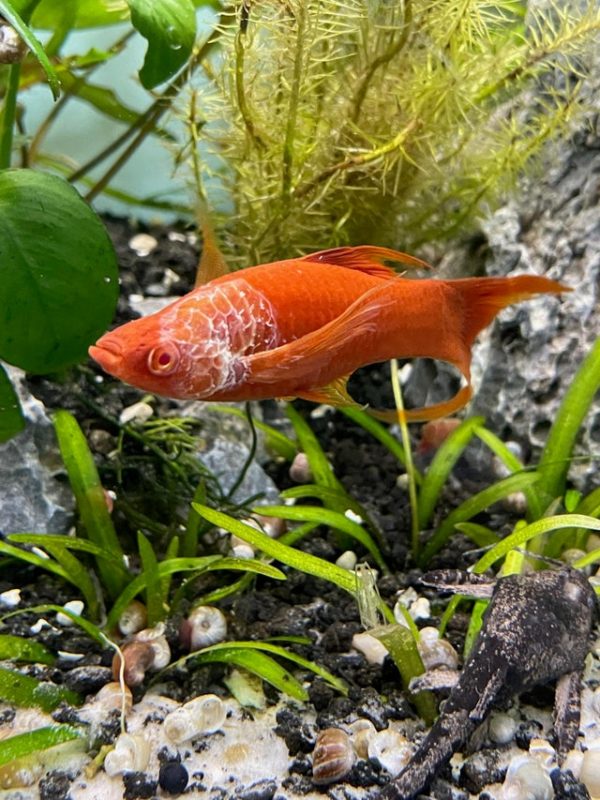
In such cases, you should always act fast and remove them from the tank to prevent infecting the remaining fish in the tank.
Ich or white spot disease is one of the most common ones that they suffer from. These are caused by ectoparasites in the tank water and result from poor maintenance and lack of water cleaning now and then. The best way to treat Ich is to increase the tank water’s temperature to 82 degrees Fahrenheit and then add one teaspoon of salt per gallon of water.
Besides Ich, these small freshwater fishes can also suffer from cottonmouth or mouth fungus is another potential disease they can suffer from. This disease causes uncontrolled fluffy growth around the mouth and the fins of the fishes. You will need to give them an antibiotic course to tend to the condition.
Are Swordtail Fishes Right for You?
The choice of housing a swordtail fish in your home aquarium is subjective. While some enjoy the unique shape and appearance of these fishes in the tank, some don’t. However, if you are a beginner who wants to house a hardy fish that comes with adaptive nature and habits, the swordtail fish is likely one of the best that you can get your hands on.
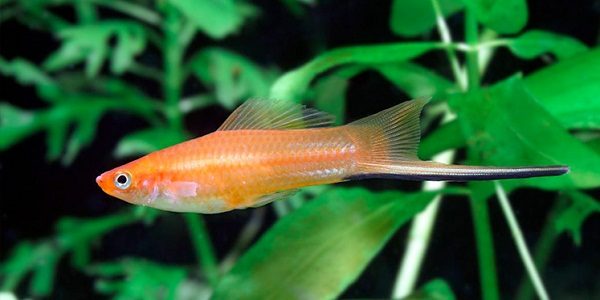
Also, if your tank is filled with other different kinds of freshwater fishes, you won’t have any issue adding a few swordtail fishes to the mix. They are friendly, adapt to changing environments, and live up to 5 years with the proper care.
FAQs
Can swordtails kill each other?
Although swordtail fishes are very friendly and of peaceful temperament, the male ones can become territorial pretty quickly. If immediate measures aren’t taken, things can take a turn for the worse, even resulting in the death of the stronger one.
Can I keep two male swordtails together?
If you are considering keeping JUST two male swordtails without any female ones in the tank, they won’t survive and will end up showing aggression on each other. Instead, try to keep them in a shoal of 5-6, including one male and four female fishes.
How many Swordtails can be kept in a 55-gallon tank?
55-gallon is a huge capacity and can house over 10-12 swordtail fishes in them. However, it all comes down to the kind of environment you create and the variety you introduce in the tank. More often than not, you should keep more females than males and have enough space for all the fishes to move around comfortably in the tank.
How often do Swordtails give Birth?
If the breeding environment is ideal, female swordtail fishes can give birth every 28 days. Since they are livebearers, they give birth to the live young directly after being impregnated.
Conclusion
If you were afraid of thinking, “How big do swordtails get?” and “what fish can live with swordtails?” we hope this article gives you all the clarity that you are possibly looking for. These beautiful and bright-colored freshwater fishes are a stunning addition to your tank and elevate the beauty of your home aquarium.
However, the best part of housing these fish is the ease of care. You don’t have to worry about premature death because they adapt themselves to the current living conditions and help reduce your burden significantly.
As long as you know about the essential care guide and the requirements, we are sure that you wouldn’t have a hard time housing a swordtail fish till their optimum lifespan. We hope this guide gives you all the details that you were on the lookout for.

13 thoughts on “Swordtail Fish: Complete Guide to Care, Breeding, Tank Size and Disease”
Well now that I have 2 sword tail fish, I have been learning a lot about them, however, how well would it work if I were to have say like 5 or 6 female sword tail fish with the 2 male swordtail fish that I have already?
I read somewhere that it’s best to keep three females to a male. Too few females and the males will chase the females to death.
The common and best ratio is 1 male to 3 or 4 female fish so 2 males with 6 female fish would be Judy fine if you take care of them all right.
Can u put different breeds of swordtail in one single school?
Yes, they all intermix well.
I have two male swordfish in one tank with 7 neon tetras as well as 2 mollies and 4 guppies. Is it alright to do this?
It will depend on your tank size. For a community like that you are going to want at least 25 gallons. The more space you have the better you will do.
1 female 1 male the female died male has tail fun & little more tail fun gone and top fun discolored. Tanks only 5 weeks old, 10 gal and with 2 female guppies and female & male mollies. All others look fine.
You need to keep at least 3 females per male. I have made this mistake before as well. Your male is probably damaged by the female as they will nip each other if they are harassed too much.
why sword tail fry dead at the birth. Any reason for it.
We have 7 to say tetra , 2 small Angel fish
size of 10p piece. We did a partial water change, cleaned plants off in some syphoned tank water. Our tank has been up and running for about 8weeks. We were told by the arquiruim shop our external tank will need cleaning in about 3 months with it being new.
We few days ago introduced 4 small swordfish
1 male to 3 females. Plus 3 full grown ones 1 male to 2 females. Second and day of new arrivals we lost 1 tetra, 2 days later we lost the bigger male sword fish and today woke up to find another tetra has died. Worring over the larger female sword fish had around the mouth looks like either been bitten or some sort of infection. It has white fleshy type material hanging from the lip area. The fish is swimming ok likes to rest in the gravel seems bit quiet around feeding time with the other fish who are quiet greedy. Any advice would be most welcome.
Looks like quite the time since any posters have commented – I’ll give it a try! So my experience is a bit different. I currently have close to 40 in a 20 gallon. Now this isnt optimum or on purpose, however its working well enough for the winter. You see I like breeding and raising fancy tailed guppies in 300 gallon totes outside in the summer, but last year for fun I had purchase three sunset orange sword tails and guess what? So its a mix of about 60/40 females to males, all siblings. Mom and Dad are in my 55 with other tropicals I have.
I have a medium pore air stone going along with a hang on filter sized for 20-55 gallons. I do use charcoal in the filter and do weekly large water changes. They have a varied diet from flakes to fresh frozen brine shrimp and some other fresh water fish frozen cube food you can buy at Petco. Awesome stuff.
Anyway, looking to create a few small ponds in the yard with cut off plastic 55 gallon drums buried into the ground and natural environmental inputs and these guys broken into groups almost like Koi. And of course with the guppies. Happy Fishing all.
Can I keep only females together or do I need a male?